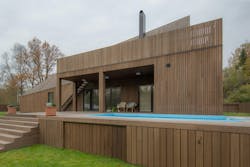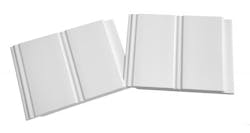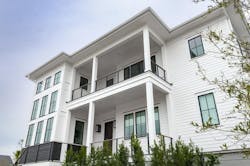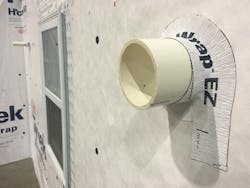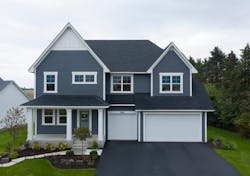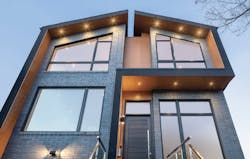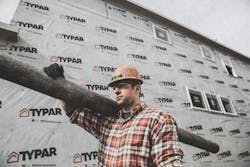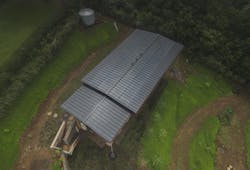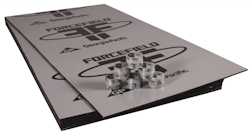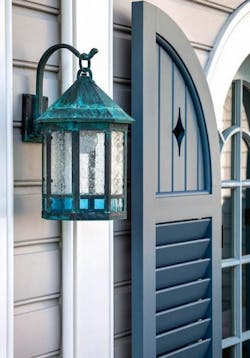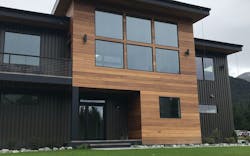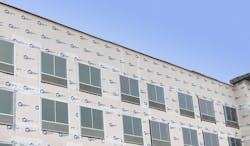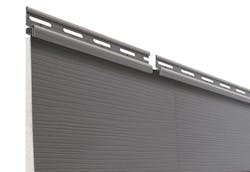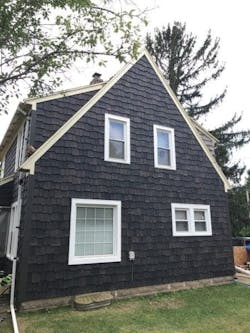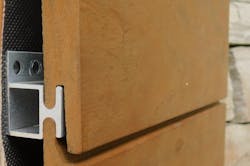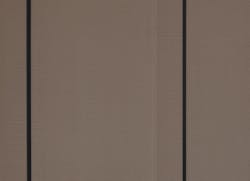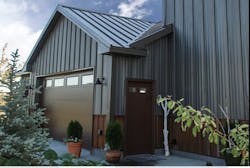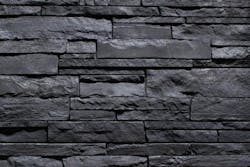2020 Home Exteriors Guide: 21 Products Offering Durability, Aesthetics
Research by online real estate firm Redfin indicates that more homeowners want attractive exteriors and want to spend less time maintaining them, which is causing manufacturers to up their game when it comes to durable, long-lasting, low-maintenance and attractive exterior products.
Homeowners want more time to spend on experiences rather than home maintenance, and they want homes that are “less cookie cutter,” says Katie Ostreko, vice president of sales and marketing for building products manufacturer Quality Edge.
[ Related: 9 VINYL SIDING ALTERNATIVES THAT MIMIC WOOD, STONE ]
Kleer Lumber
This latest beadboard product is a fully extruded PVC that is sealed on all four sides to keep the cellular structure and inner core from exposure. It comes in 16-foot lengths and is easy to cut and fit with the same tools used for wood. Extruded in white, it can be painted in 100 percent acrylic latex and offers the look of wood. Impervious to moisture and insects, the beadboard installs easily with a hidden nailing flange.
When it comes to siding, homeowners want a look that’s simple and not ornate, but not flat. They want a bit of “visual texture” says architect Todd Miller, president of QMA Architects in Ventnor, N.J. But they don’t want to just use a variety of materials such as stone, wood, brick, fiber cement, and metal; they want to create shadow lines where boards overlap or staggering the edges on shakes.
Ostreko adds that “the inside is moving outside. Things like accent walls in different colors and materials.” A garage wall of stone or steel planks, for example. The same thing is happening with color, black in particular. Inside the home, black is showing up on everything from hardware to lighting. But it’s being pulled outside too—on window frames and exterior accent walls, particularly on contemporary homes. In general, though, when it comes to siding more and more consumers are opting for darker, richer colors.
The Aspyre Collection by James Hardie
The fiber cement company paired the thick (5/8-inch) distinctive profiles of its Artisan product with the smooth, geometric Reveal Panel System to create Aspyre. Artisan’s thickness means deep profiles with shadow lines that create strong horizontal and vertical definition. Reveal is a complete, customizable system of commercial-grade panels, trims, and fasteners. The panels can be installed horizontally or vertically.
Aside from style, sustainability and durability top the list of trends. It’s been widely reported that homeowners—millennials, boomers/empty nesters—want to spend time traveling and enjoying other experiences and not tending to their homes in their spare time or spending money on constant upkeep. They want exterior home products that will hold their color and not need painting, that are sustainable and kind to the environment, and will survive whatever Mother Nature throws at them.
Although they can’t see it, what’s behind the siding will help homeowners get the durable, sustainable homes they desire. Industry data shows that over 65 percent of construction litigation still stems from moisture-related defects in building envelope systems, says Jeff Wedge, vice president of sales, for Henry Residential & Light Commercial, parent company of Fortifiber, Blueskin, WeatherSmart, and Jumbo Tex.
[ Related: 9 HOUSEWRAPS THAT BLOCK AIR BUT ALLOW WATER VAPOR TO ESCAPE ]
Tyvek
FlexWrap EZ adhesive is a derivation from the brand’s flashing products for sills and windows. The newer wrap is a narrow version measuring 2¾ inches that comes in a 15-foot roll and is used to seal smaller wall penetrations in the building envelope. Made of 100 percent butyl adhesive, it sticks to any common construction material, and has a 270-day UV exposure.
Water and air leakage and infiltration are the main culprits, which is why more jurisdictions are taking action or considering it. Bijan Mansouri, Typar construction technical manager, says “a few years ago, Oregon required a drainable wrap behind the siding and now several states are requiring it as well. Drainable is a key focus in the industry.”
Sustainability is on everyone’s mind and it’s only going to loom larger. One exterior element that is gaining traction is solar. The number of home solar installations has reached more than 2 million, and the industry is growing.
LP
LP’s prefinished Smartside Trim and Siding comes in lap siding, trim and fascia, shingles and shakes, panels and vertical siding, and soffit. The portfolio comes in 16 colors such as Redwood red and Rapids blue as well as a variety of finishes.
“The tremendous growth in the U.S. solar industry is helping to pave the way to a cleaner, more sustainable energy future,” the Department of Energy writes on its website. “Over the past few years, the cost of a solar energy system has dropped significantly—helping to give more American families and business access to affordable, clean energy.”
Through a variety of research and development efforts, DOE says it remains committed to leveraging America’s abundant solar energy resources—driving research, manufacturing, and market solutions to support widespread expansion of the nation’s solar market.
Boral
Boral’s Vista concrete roofing comes in five colors and two tile styles, slate and shake. The contemporary tiles carry a class A fire rating, meaning the tiles are a resilient option for fire-prone areas.
That expansion includes the development of new products. One such product is from 3 In 1 Roof, a new Florida-based company that has developed a roofing tile that combines insulation, wind protection, and solar power in a single product. President and CEO Carmen Bellavia calls the product “the solar industry’s supreme solution.”
The company’s roof tiles are constructed from a layer of heat-resistant, closed-cell foam coated with a geopolymer. According to the company, the material improves solar performance and insulation by keeping roof temperatures down during sunlight hours.
Royal Building Products
Cedar Renditions, an aluminum siding by Royal Building Products, offers a moisture-proof, non flammable, and almost maintenance-free siding coverage, according to the company. It is available in five colors and a 6-inch profile that features overlapping notches to create a longer length.
Traditional blue and black silicon solar cells have an average efficiency rating of around 22 percent, but they can experience a functionality loss of 5 percent for every 20 degrees the roof surface rises above 120 degrees Farenheit, the company says. On a typical 88-degree day, traditional roofing materials can collect enough solar heat to reach up to 150 degrees by mid-afternoon, losing energy production potential during the sunniest part of the day.
3 In 1 says it roofing product, on the other hand, reaches just 12 degrees above air temperature at any given time. In addition, while common roofing materials, such as asphalt and concrete, take a long time to cool after reaching high temperatures, 3 In 1 Roof tiles rise and fall in temperature at nearly the same rate as the surrounding air. The result is a solar system that won’t lose efficiency unless daytime temperatures are consistently above 110 degrees.
Typar
Drainable Wrap goes up like traditional housewrap and is nearly 95 percent drainage efficient. Made of a proprietary spun bonded polypropylene with a microporous coating, drainable wrap is durable and strong and is compatible with other company’s building components. It comes in rolls of 5 by 100 feet and is thicker—about 13 millimeters—than competitor materials, the company says.
Another product is from Sunflare. The company’s PowerFit 20 lies flat, nestled between the seams of metal standing seam roofs. Each 60-watt panel can be connected to cover whatever length the roof demands. Installation is fast and easy with no roof penetrations. The modules come with a butyl adhesive backing—just peel and stick for a hold secure enough to withstand gale force winds. Made of copper, indium, gallium and selenide—the cells deliver more energy at dawn and dusk than traditional solar panels, the company says. Each individual cell has a bypass diode so that if it’s shaded, only that individual cell is inactive (as opposed to a whole string being knocked out).
Sunflare's PowerFit 20 lies flat, nestled between the seams of metal roofs.
6 Things You May Not know About Solar Energy
1. California’s Mojave Desert is home to Ivanpah Solar Power Facility, the world’s largest operating solar thermal energy plant.
2. As prices continue to fall, solar energy is increasingly becoming an economical energy choice for American homeowners and businesses. Still, the biggest hurdle to affordable solar energy remains the soft costs—such as permitting, zoning and hooking a solar system up to the power gird.
3. Today, demand for solar in the United States is at an all-time high. The amount of solar power installed in the U.S. has increased more than 23 times over the past eight years—from 1.2 gigawatts (GW) in 2008 to an estimated 27.4 GW at the end of 2015. The U.S. is currently the third-largest solar market in the world and is positioned to become the second.
4. The space industry was an early adopter of solar technology. In the 1950s, the space industry began to use solar technology to provide power aboard spacecraft.
5. The first silicon solar cell, the precursor of all solar-powered devices, was built by Bell Laboratories in 1954.
6. Solar energy is the most abundant energy resource on earth—173,000 terawatts of solar energy strikes the Earth continuously. That's more than 10,000 times the world's total energy use.
Source: U.S. Department of Energy
Huber Engineered Woods
The manufacturer of the ZIP System sheathing system has expanded its line of sealing solutions and enhanced flashing tapes. Now consisting of five ZIP System stretch tape options and five ZIP System flashing (straight) tapes, the collection can be applied down to 0-degree and 120 degrees Fahrenheit.
Georgia-Pacific
ForceField is an air-and-water-barrier system that consists of structural engineered wood sheathing panels featuring a laminated air and water barrier. Once installed and the panel seams are taped with ForceField seam tape. The brans says it creates a code-compliant, integrated system that eliminates the need for housewrap, making life easier and faster for builders.
Timberlane
With Combination Shutters by Timberlane, homeowners can mix and match styles in the same shutter. Clients can choose different panels, cutouts, louvres, and configurations to create a unique look.
Nova
Rainscreen Hardwood Siding by Nova is designed to allow air circulation around the perimeter of each plank of wood, which the company says helps protect the quality and integrity of the siding’s structure by stabilizing the outer cladding boards. The composite hardwood is made of ipe, batu, and cumaru.
NDEVCO Building Products
With a non-directional gap design that can be installed in any direction, Barricade Wrap Plus Drainage can perform at up to 90 percent drainage and act as a windbreaker and rainscreen.The breathable wrap resists bulk water, UV rays, and surfactants.
CertainTeed
CERTAplank reinforced siding: Because of its lightweight design, CertainTeed’s CERTAplank reinforced siding requires no special tools for installation, and the 7-inch, vinyl cladding is chip and crack resistant. The company says it delivers the look of a modern hardboard without the hassles of its installation.
DaVinci
Available in 8 colors, DaVinci’s Hand-Split Shake siding captures the look of cedar without the maintenance with its durable design that resists fading, rotting, cracking, and pests. The company says its thick groves and realistic grain give siding depth.
Kebony
The Passive Rainscreen System by Kebony features clip fasteners and wood siding that is treated with a bio-based liquid to improve durability. Kebony says the clip fastener and façade profile provide a clean look and eliminate the need for pre-drilling, which significantly reduces installation costs while eliminating water penetration.
Chelsea Building Products
One of the largest board and batten profiles on the market, the Everlast Board & Batten Vertical Siding, a composite siding by Chelsea Building Products, comes in a 12-foot length that the company says eliminates seams and transitions for projects that might have required more than one panel. It is available in six colors and features a wood-grain embossed finish.
Bridger Steel
Bonderized metal by Bridger Steels is available in 24 gauge steel for residential, commercial, and agricultural projects. Its dark, natural-looking finish is created by taking metal panels and coating them with a phosphate mixture. Builders can choose custom finishes as well such as rustic copper.
Versetta Stone
Versetta Stone’s Tight Cut siding installs without the need for additional footings or support and is weather-resistant. The panels, which cover 2-square-feet each, come in six colors such as the new Northern Ash, a bold, dark color.
Meridian
With the Meridian Authintic Brick, builders can create the traditional brick look, but without the heaviness. The lightweight brick comes in 23 colors and can be used exterior and interior spaces in new residential projects or remodels.
To read our previous Product Guide, click here: 2020 APPLIANCE GUIDE: WHAT YOU SHOULD KNOW PLUS 25 PRODUCTS TO CONSIDER
